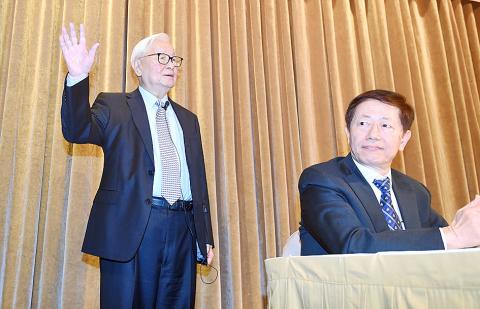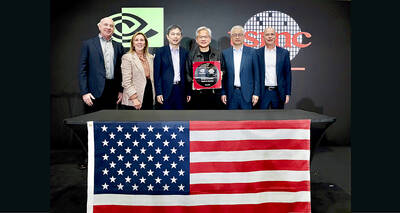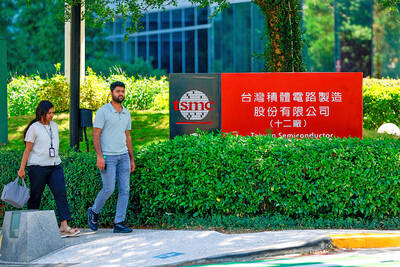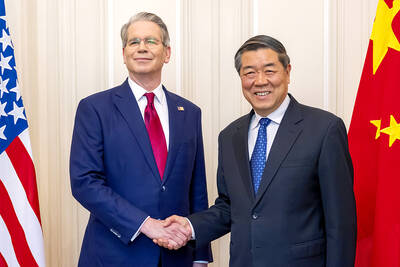Taiwan Semiconductor Manufacturing Co (TSMC, 台積電), the world’s largest contract chipmaker, yesterday posted a record-breaking net profit of NT$343.11 billion (US$11.61 billion) for last year, benefiting from robust chip demand for smartphones and cryptocurrency mining machines.
That represented an annual growth of 2.65 percent from NT$334.25 billion in 2016, according to the chipmaker’s financial statement. Earnings per share rose to NT$13.23 from NT$12.89.
While the pace of growth decelerated from 2016’s 10 percent increase, the chipmaker expects the growth momentum to carry on this year.

Photo: Liao Chen-huei, Taipei Times
This year will be “an above-average year,” TSMC founder and chairman Morris Chang (張忠謀) told investors at his last appearance at the company’s quarterly earnings conference.
Chang is set to retire this summer.
Revenue growth would accelerate to between 10 and 15 percent this year in US dollar terms, following a 9 percent increase last year, Chang said.
That would be faster than the company’s five-year target of compound annual growth of between 5 and 10 percent from last year to 2021.
Chang said he expects growth to be fueled by three of the firm’s growth platforms: high-performance computing (HPC), Internet of Things and automotive.
Replacing mobile phone chips, “HPC chips will grow the strongest due to continuing expansion of AI [artificial intelligence] applications in all electronic devices, as well as continuing demand for cryptocurrency GPU [graphics processor unit] and etc,” Chang said in English.
“The urge to mine cryptocurrency is very strong. The [cryptocurrency] price is very volatile, but the demand since the last year has been very strong. We expect it will continue to be strong,” he said.
“However, we will size the demand carefully,” he added.
Mobile phone chips, the biggest revenue contributor to TSMC, would see little growth this year, he predicted.
Based on Chang’s growth projection, TSMC would again outperform the global semiconductor industry’s projected annual growth of between 6 and 8 percent, and the foundry sector’s annual growth of between 9 and 10 percent this year.
However, due to the smartphone industry’s slow-season effect, TSMC expects revenue to shrink by 8.3 percent sequentially this quarter to between US$8.4 billion and US$8.5 billion.
Gross margin is expected to reach between 49.5 percent and 51 percent this quarter, compared with 50 percent last quarter, TSMC said.
The company’s net profit dropped 0.9 percent to NT$99.29 billion in the final quarter of last year, compared with a record-high NT$100.2 billion in the fourth quarter of 2016.
The company attributed the contraction to a 1.5 percent appreciation of the New Taiwan dollar against the US dollar.
On a quarterly basis, net profit increased 10.4 percent from NT$89.93 billion, the company’s financial statement showed.
To support the company’s growth and customer demand, TSMC plans to spend between US$10.5 billion and US$11 billion this year, mainly on new equipment for 7-nanometer manufacturing and developing 5-nanometer technology.
TSMC is on track to start mass production of its 7-nanometer chips — mostly for smartphones and AI applications — next quarter, TSMC cochief executive C.C. Wei (魏哲家) told the conference.
The 7-nanometer chips are to account for 10 percent of the company’s total revenue this year, Wei said.

RECYCLE: Taiwan would aid manufacturers in refining rare earths from discarded appliances, which would fit the nation’s circular economy goals, minister Kung said Taiwan would work with the US and Japan on a proposed cooperation initiative in response to Beijing’s newly announced rare earth export curbs, Minister of Economic Affairs Kung Ming-hsin (龔明鑫) said yesterday. China last week announced new restrictions requiring companies to obtain export licenses if their products contain more than 0.1 percent of Chinese-origin rare earths by value. US Secretary of the Treasury Scott Bessent on Wednesday responded by saying that Beijing was “unreliable” in its rare earths exports, adding that the US would “neither be commanded, nor controlled” by China, several media outlets reported. Japanese Minister of Finance Katsunobu Kato yesterday also

Jensen Huang (黃仁勳), founder and CEO of US-based artificial intelligence chip designer Nvidia Corp and Taiwan Semiconductor Manufacturing Co (TSMC, 台積電) on Friday celebrated the first Nvidia Blackwell wafer produced on US soil. Huang visited TSMC’s advanced wafer fab in the US state of Arizona and joined the Taiwanese chipmaker’s executives to witness the efforts to “build the infrastructure that powers the world’s AI factories, right here in America,” Nvidia said in a statement. At the event, Huang joined Y.L. Wang (王英郎), vice president of operations at TSMC, in signing their names on the Blackwell wafer to

‘DRAMATIC AND POSITIVE’: AI growth would be better than it previously forecast and would stay robust even if the Chinese market became inaccessible for customers, it said Taiwan Semiconductor Manufacturing Co (TSMC, 台積電) yesterday raised its full-year revenue growth outlook after posting record profit for last quarter, despite growing market concern about an artificial intelligence (AI) bubble. The company said it expects revenue to expand about 35 percent year-on-year, driven mainly by faster-than-expected demand for leading-edge chips for AI applications. The world’s biggest contract chipmaker in July projected that revenue this year would expand about 30 percent in US dollar terms. The company also slightly hiked its capital expenditure for this year to US$40 billion to US$42 billion, compared with US$38 billion to US$42 billion it set previously. “AI demand actually

RARE EARTHS: The call between the US Treasury Secretary and his Chinese counterpart came as Washington sought to rally G7 partners in response to China’s export controls China and the US on Saturday agreed to conduct another round of trade negotiations in the coming week, as the world’s two biggest economies seek to avoid another damaging tit-for-tat tariff battle. Beijing last week announced sweeping controls on the critical rare earths industry, prompting US President Donald Trump to threaten 100 percent tariffs on imports from China in retaliation. Trump had also threatened to cancel his expected meeting with Chinese President Xi Jinping (習近平) in South Korea later this month on the sidelines of the APEC summit. In the latest indication of efforts to resolve their dispute, Chinese state media reported that